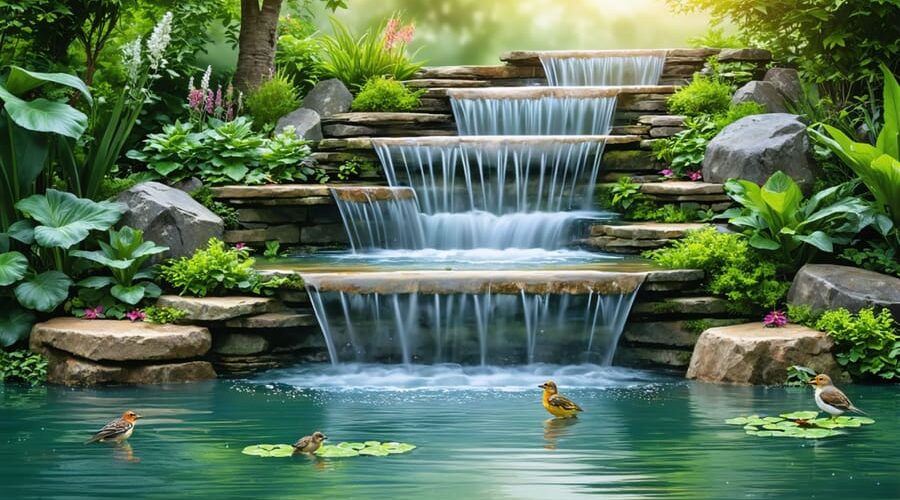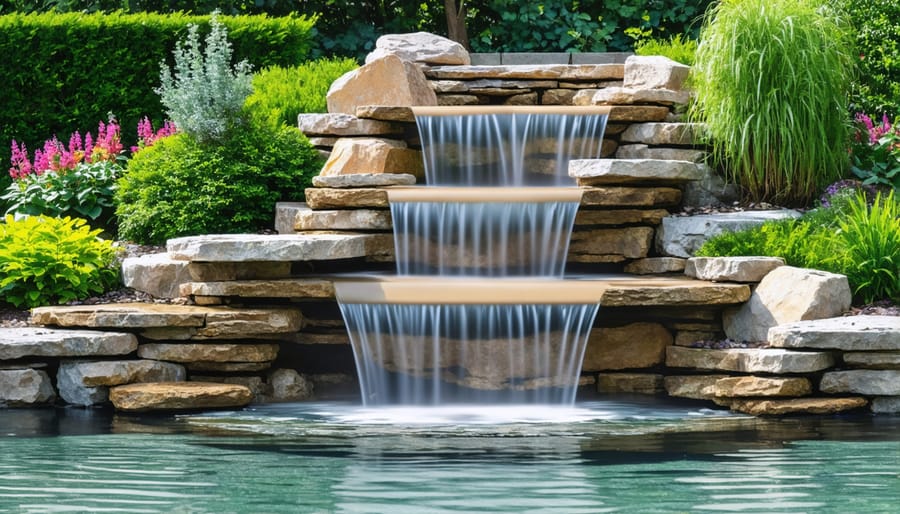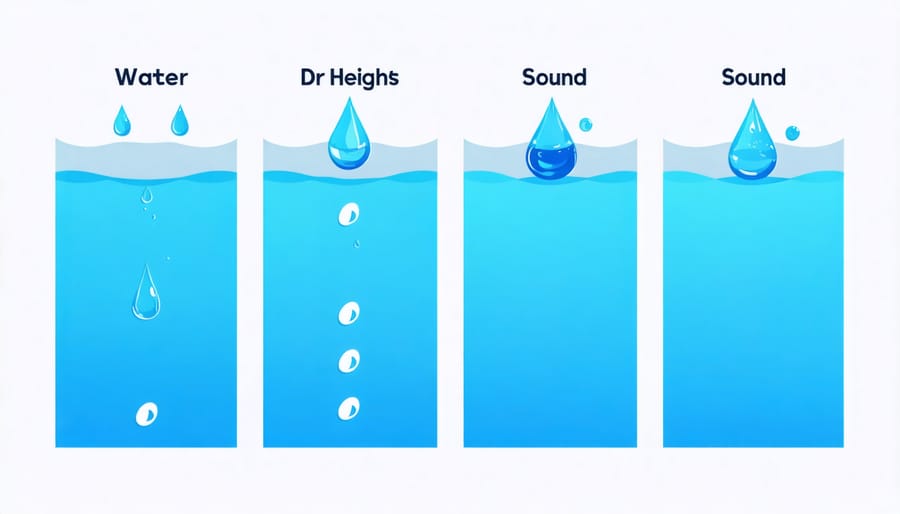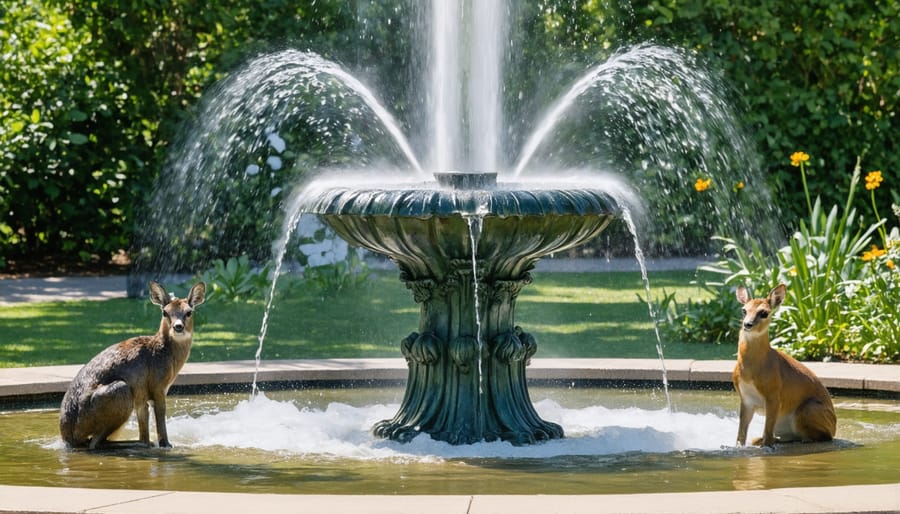
Transform Your Pond into a Soothing Sanctuary: Creating the Perfect Water Symphony
The gentle splash of falling water, the melodic trickle over rocks, and the soothing ripples across a pond’s surface create nature’s most captivating symphony. These enchanting pond sounds do more than just please the ear – they transform ordinary backyards into peaceful retreats, mask unwanted noise from busy streets, and create the perfect environment for both relaxation and entertainment.
Whether you’re designing a new water feature or enhancing an existing pond, understanding how to craft and control these aquatic acoustics can elevate your outdoor space from simple to spectacular. From the dramatic roar of a cascading waterfall to the subtle music of a bubbling spring, pond sounds offer endless possibilities for customization. The key lies in carefully selecting and positioning your water features to achieve the perfect balance of sound and serenity.
Ready to orchestrate your own water symphony? Let’s explore how different water features, flow rates, and design elements work together to create the perfect soundtrack for your outdoor sanctuary.
Natural Water Sounds: The Foundation of Your Pond Symphony
Waterfalls and Cascades
Waterfalls and cascades add dynamic movement and enchanting sounds to your natural pond design. Each style creates its own unique symphony, from gentle trickles to dramatic splashes. Single-drop waterfalls produce a focused, steady stream of water that creates a bold, consistent sound – perfect for drowning out nearby traffic or unwanted noise. Multi-tiered cascades, on the other hand, offer a softer, more varied sound as water dances down multiple levels.
For a gentle, soothing effect, consider a stepped waterfall where water flows over a series of flat stones. This creates a musical babbling sound that’s particularly relaxing. Rock-scattered cascades, where water weaves between carefully placed boulders, produce a more natural, stream-like sound that varies with water flow.
The height and volume of your waterfall directly affect its sound level. A fall of 2-3 feet typically provides pleasant ambient sound without overwhelming your space. Remember, you can always adjust the flow rate using a variable-speed pump to fine-tune the perfect sound for your outdoor sanctuary.

Streams and Rills
Streams and rills add a delightful dimension to your pond’s soundscape, creating gentle, musical water sounds that soothe the soul. These shallow, meandering waterways can be designed to produce anything from a soft whisper to a playful gurgle, depending on their slope and construction.
To create the perfect stream sound, start with varying the width and depth of your channel. Wider sections slow the water flow, producing softer sounds, while narrow passages create more pronounced babbling effects. Adding small drops and curves along the stream’s path enhances the sound variety.
Natural stone placement is key to crafting authentic stream sounds. Position flat rocks to create mini waterfalls, and use rounded stones to direct water flow. The height of these drops significantly impacts the sound intensity – a 2-inch drop produces a gentle trickle, while a 6-inch drop creates a more dramatic effect.
Consider incorporating multiple streams of different sizes or creating a series of small cascades. This layering of sounds adds depth to your water feature and helps mask unwanted background noise naturally.
Designing Your Pond’s Soundscape
Water Drop Heights and Sound Control
The height from which water falls plays a crucial role in determining the sound your pond makes. As a general rule, the higher the drop, the louder and more dramatic the sound will be. A gentle 6-inch drop creates a soft, pleasant trickling noise perfect for meditation gardens, while a 2-foot drop produces a more prominent water feature sound that can help mask urban noise.
To adjust your water drop height, start by experimenting with different stack heights of rocks or adjusting your waterfall’s elevation. If you find your current sound too loud, try breaking up the fall into several smaller drops using flat stones. This creates a cascading effect that softens the overall sound while maintaining visual appeal.
You can also control sound intensity by adjusting your pump’s flow rate. A variable-speed pump gives you the flexibility to change water flow throughout the day – perhaps louder during afternoon gatherings and gentler for evening relaxation. Consider adding flow regulators or ball valves to fine-tune the water volume.
Remember that surrounding surfaces affect sound too. Hard materials like concrete or large rocks will amplify sounds, while softer materials like plants or moss can help absorb and diffuse them. By combining these elements thoughtfully, you can create your perfect pond symphony.

Rock Placement and Sound Enhancement
The strategic placement of rocks in your pond can dramatically influence the sound of flowing water, creating a personalized audio experience in your garden. By positioning rocks of various sizes, you can shape water sounds from gentle trickles to dramatic cascades, while helping to create visual contrast in your water feature.
For a soft, melodic sound, arrange flat rocks in a gentle slope, allowing water to flow smoothly across their surfaces. This creates a peaceful, sheet-like effect perfect for meditation gardens. To achieve a more pronounced babbling sound, position round rocks of varying sizes to create multiple small drops and diversions in the water’s path.
Large boulders can be used to direct water flow and create deeper, resonating sounds. Place them strategically at waterfall points, ensuring water hits deeper pools below for that satisfying plunge effect. For a more musical quality, experiment with hollow spaces between rocks where water can create echo chambers.
Remember that the height of water drops significantly affects sound volume. A fall of just a few inches produces gentle sounds, while drops of several feet create more dramatic effects. Start with smaller arrangements and adjust until you find your perfect sound balance – you can always add more rocks or rearrange them as needed.
Complementary Sound Elements
Fountains and Spitters
Fountains and spitters come in various styles, each creating its own unique sound profile that can transform your pond’s atmosphere. From gentle bubblers to dramatic cascades, these water features offer endless possibilities for customizing your garden’s soundscape.
Simple spitters, like frog or fish designs, produce a delicate trickling sound that’s perfect for intimate spaces. These charming additions work well in smaller ponds and create a subtle background melody that won’t overwhelm nearby seating areas.
Tiered fountains generate a more prominent water sound, with each level contributing to a harmonious blend of splashes. These elegant cultural water features can range from classical European designs to Asian-inspired pieces, each offering distinct sound characteristics.
Bell fountains create a unique hollow sound as water flows over a dome-shaped surface, while spray fountains can be adjusted to produce anything from a fine mist to a bold jet. The height and spread of your fountain directly affect its sound volume – higher sprays generally create louder, more dramatic effects.
For the best sound control, consider installing a variable-speed pump. This allows you to adjust the water flow and, consequently, the sound intensity to match different times of day or various outdoor activities.
Surrounding Plants and Wildlife
The natural symphony around your pond comes from more than just water – the surrounding plants and wildlife play crucial roles in creating a rich, layered soundscape. Tall grasses like bamboo and ornamental reeds create gentle rustling sounds when touched by the breeze, adding a peaceful backdrop to your water features. Cattails and rushes near the water’s edge contribute their own subtle whispers while providing shelter for pond residents.
Birds are particularly drawn to water features, bringing their cheerful songs and splashing sounds as they bathe and drink. Consider adding bird-friendly plants like berry bushes or flowering perennials to attract more feathered visitors. Frogs and toads often make themselves at home in pond environments, contributing their distinctive croaking chorus, especially in spring and summer evenings.
Insects like dragonflies and bees buzz around water-loving flowers, while crickets and katydids add their evening songs to the mix. Even fish can contribute subtle splashing sounds when they surface to feed. To enhance these natural sounds, create different habitat zones around your pond – shallow margins for amphibians, dense plantings for birds, and open areas where wildlife can safely access the water.
Remember that these natural sounds will change with the seasons, creating an ever-evolving acoustic environment that makes your pond a living, breathing ecosystem.

Troubleshooting Common Sound Issues
Even the most well-designed pond can sometimes develop sound issues, but most are easily fixable. If you’re hearing splashing that’s too loud, try adjusting the height of your waterfall or fountain. Lowering the water flow rate can significantly reduce excessive noise while maintaining the pleasant ambient sound you’re after.
For pumps making unusual noises, first check for debris blockage. Clean the pump intake and filter regularly to prevent grinding or buzzing sounds. If the noise persists, ensure your pump is properly seated and not vibrating against hard surfaces. Using rubber mounts or padding can help dampen unwanted vibrations.
Gurgling or air bubble sounds often indicate that water levels are too low, causing air to be pulled into the system. Maintain proper water levels and check for leaks around pipe connections. Sometimes, simply repositioning rocks around your waterfall can eliminate unwanted splashing or create a more melodious sound.
For echo issues in smaller ponds, try adding more plants or varying the depths of your water features. These natural elements help absorb and diffuse sound waves. If you’re dealing with water sounds that seem too quiet, consider adding small cascades or multiple falling water points to enhance the audio experience without overwhelming your space.
Remember that sound preferences are personal – what’s soothing to one person might be too loud for another. Don’t hesitate to experiment with different adjustments until you find your perfect pond harmony.
The gentle sounds of moving water can transform any outdoor space into a peaceful sanctuary. Whether you choose a cascading waterfall, bubbling fountain, or subtle stream, your pond’s soundscape will create a unique atmosphere that enhances your entire garden experience. Remember that you can easily adjust water flow rates and feature heights to fine-tune the perfect sound level for your space. Don’t be afraid to experiment with different combinations of water features to create your ideal audio environment. With the knowledge and tips shared in this guide, you’re well-equipped to design a pond that not only looks beautiful but sounds magnificent too. Start small if you need to, and let your pond’s symphony grow along with your confidence. Your perfect water garden soundscape awaits – it’s time to get started!
